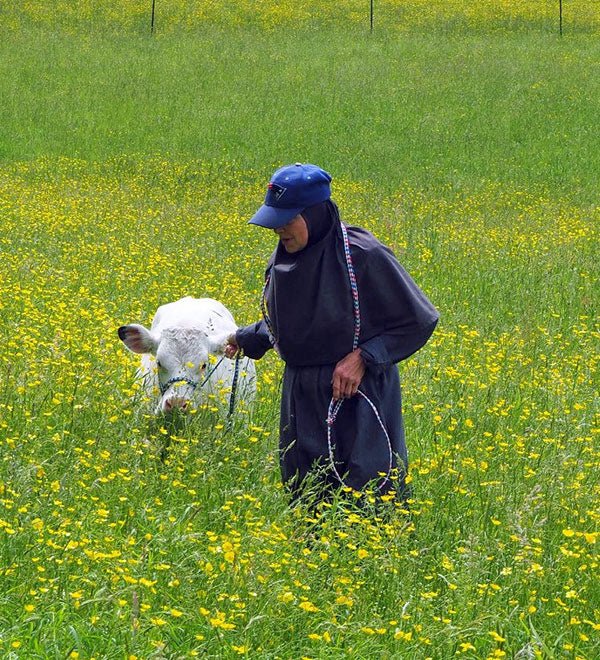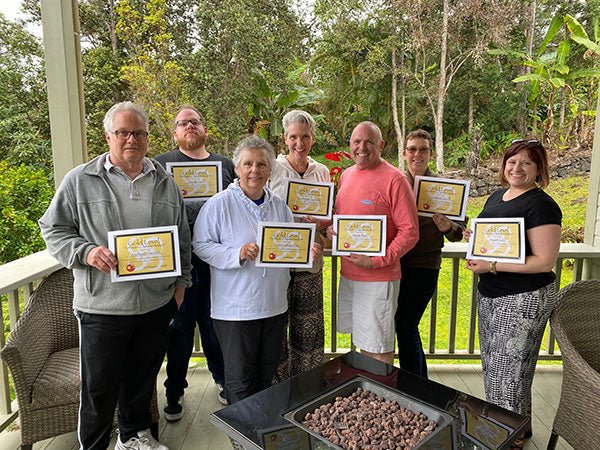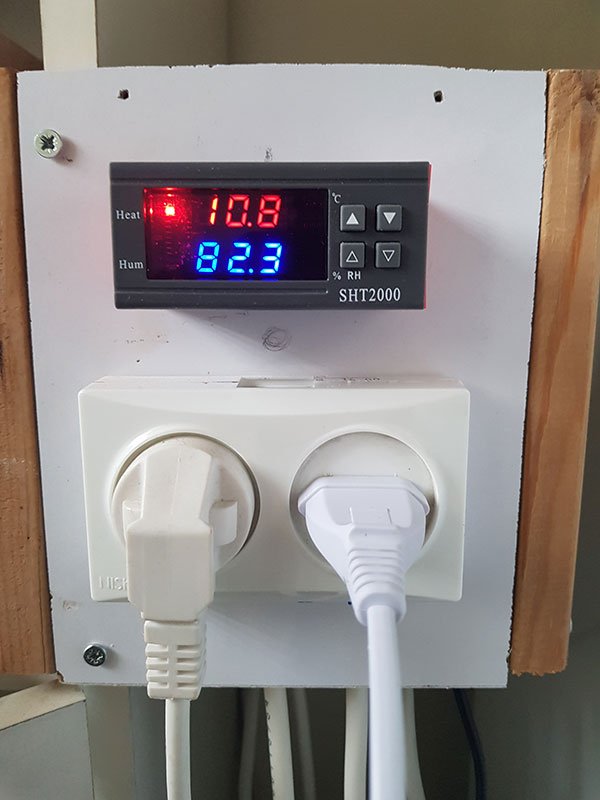

Mother Katherine in July, 2019
Zoar Farm at Holy Myrrhbearers Monastery

January, 2018
This is an unusual interview with an unusual woman.
Mother Katherine is all about her flock and not about the world as most of us know it. She is a shepherd in the old-style – that is, she lives with her sheep and goats and she sings to them as she works. She knows each of them intimately and she loves to talk about them. We think they are lucky indeed to have her as their protector.

We were also lucky to have captured a few minutes of her time for this interview. Mother Katherine makes cheese for the monastery, but her joy comes from the time she spends outdoors with her flock.

January, 2018
She sent most of the pictures below to us in the mail and we scanned them. (Technology won’t distract her from her work.) There was only one of herself included, but, fortunately, we found a few more on the monastery’s Facebook page- https://www.facebook.com/Otegonuns

July, 2019 with a pair of bull calves
Her Story

The lamb is Icelandic ewe Una. She went on to have a good career as a milker, mama and fleece producer. She was out of most of our milk lines and I made lots of cheese yogurt from her and made “lambbars” – frozen instant pudding pops. mmmmmm.
I really don’t have a cheese making “operation” as such. We keep some Saanen goats, some Icelandic sheep and I buy Jersey milk occasionally from a local dairyman. I make cheese for our own consumption. Lambs may start appearing as early as April 12.

Pressed fresh cheese
I always wanted to be a nun. I came to the monastery in February, 2001, when I was 48. The sheep and goats were both here then. The goat herd were “scrubs” picked up here and there to reclaim the abandoned property of of burdocks and so forth back in the late nineties. The sheep were added a year or two after to satisfy the fiberholics in the community who lived to knit. They did attempt a grass-based lamb operation but that wasn’t really feasible at that time.

Hardy Icelandics and a churro enjoying a sunny winter day.
After I came, the abbess saw her chance to upgrade the goats to purebred Saanens with a view to an operating stud and dairy business. After many vicissitudes, that pretty much never happened.
After I took over the ag department solo, I axed the meat/lamb attempt as unworkable and began looking into other avenues for the sheep and their fiber – without selling the girls themselves. (Think about it: dairymen don’t sell their cows, they sell the milk.)

Icelandic ewe Thora and her 2 1/2 pound baby-Dimma. Thora took to being milked without any drama whatsoever.
One of the monastery’s early mentors was Peter Constantinou, originally from Cyprus where his family had a sheep/goat dairy. They routinely, as he does now, had goats freshen before the sheep or cows to provide colostrum and milk if necessary. Goat milk is acceptable to many species, including fawns.

CeCe – a Saanen doe with her son, Periwinkle
In past years, we raised many lambs and some kids on goat’s milk (not mama’s) especially during the time we were eradicating the incidence of CAE in the goats and OPP in the sheep. Mamas were affected, so babies were taken at birth and bottle raised from the colostrum (from a “clean” doe) right up through weaning.

Sir Ritchfield and his twin Melmoth.
3 years ago, a lamb Ewe, (say, ee-wee) wandered into the “big pen” less than an hour after birth. Her mama no longer recognized her. The lamb REFUSED to drink milk replacer. Meanwhile, Claire (a goat) freshened with triplets and had milk to spare. The lamb took the goat milk without a grumble and we raised her on that.

American/Sable Saanen, Claire. She’s out of the Oberhasli line. She produced triplets and had enough milk besides to feed Ewe – who REFUSED to swallow milk replacer.
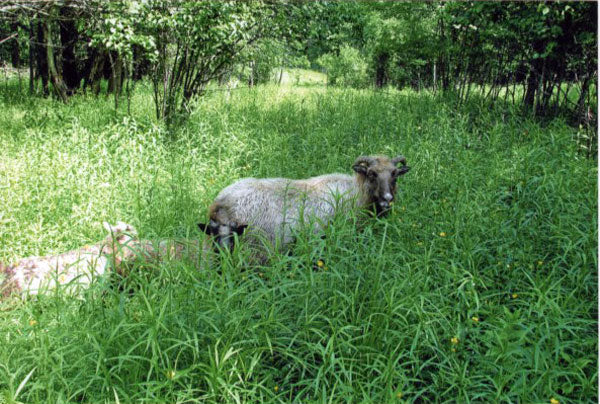
Ewe’s mother Una from a line of milking ewes in Montana. Shown with her twins Erik the Black and Caliban (brush up on your Shakespeare).

Ewe (say, ee-wee) and her first lamb-Groa. Icelandics.
We went to Canada to Bobcaygeon, Ontario to Lloyd Wicks for Saanen doe stock and another farm there for a stud. He, at that time, had the top producing Saanen doe in the country. We bred up from them.

CeCe – Her kid died after 24 hours and she tried to as well from grief. I finally convinced her that her sister Eleanor had her baby. When Eleanor freshened, I left her the first kid, took the 2nd as it slipped out and asked CeCe if she wanted it. Did she ever! Saved her life and her lactation. Baby’s name is Klementine.

Best I could do for Jolie. She expects her first kids in April. Her grammy and CeCe’s grammy were full sisters from the Canadian line.
An old ewe, Janie, lambed and went down from a pinched nerve. Her lambs needed colostrum so I went and milked her for some. She took to it like a duck to water. She was an old-style Romney: short legged and fleecy EVERYWHERE. I had to use a commercial cottage cheese dish to get under her; didn’t have to tie or bribe her to stand. The milk was a little gamey because of her fleecy bag, but that gave me the basic idea.

Cosette, Romney mix from a rescued ewe, Big Fleeces – big mouth, big single lambs and a big udder. She stands very well to be milked. She’ll be 12 this spring.
I am the shepherd and now have seen most if not all these girls right from conception on through their lives. Our vet is into teaching so I do much of the doctoring myself as well (I am a nurse from “before”). You’d be surprised at how many terms the stock understand, including treatment descriptors: pick(shot), medicine(oral), feet(nail trimming), doctor(vet), among others.

At the end of the summer, the Southern Tier Sheep producers hold their annual wool pool. Many producers don’t use fleeces or have fleeces too damaged for use in yarn. We all get together early in September and volunteer to prepare the wool for use by the factory which won the bid.
Like my human patients before, I like the stock not to be taken by surprise by what I do. They know what to expect and are less nervous. There are also a whole raft of verbal indicators for the milking routine: go to work; clock in; wash you; stand over; ready?; and so forth. The release is “okay” or “all done.”

Last daughter of foundation ewe Kira. She was wandering within hours of birth so I called her Odysses. She was a gift from her mother to me – very pointedly so – and I loved her dearly. She wouldn’t let down and drop, so she didn’t have much of a dairy career.

And now, just for kicks, baby Fosco in his elf hat. He’s a Babydoll cross and so cute you can’t stand it. He refused the portrait I wanted and insisted on a profile. So, I had to agree or give up. See his wicked smirk?
Her Cheese
Saanen milk is very homogenized naturally and low butterfat – yogurt or soft farmer’s cheese doesn’t set up well. The Icelandic is very rich and creamy – makes a nice thick yogurt. The Romney sheep milk is somewhere in between.
I took a cheese making course years ago from Peter Dixon at SUNY Cobleskill to see what else we could do with the milk. He avoided our sample as long as he could – expecting it to be Toggenburg like. Everybody was astounded at how sweet and mild the Saanen milk is.
The cows’ milk I use is from a friend and neighbor up the hill who has a mixed Jersey herd. I also got my first bull calves from him to train as oxen.

Whey from 1 gallon Jersey milk – approx. 3 qts. Good for mysost, ricotta, or bread or soups (Leek).
I foisted my first cheese attempts on unsuspecting church people attending services and watched their amazement when I dropped the bomb of its provenance after they commented on how good it was.
In the years following those first attempts, I’ve made Gouda complete with little “eyes;” cheddar; haloumi; chevres; an overdried pressed cheese I used as a grating cheese; fromagina; a simple rennet set people have called a squeaky cheese; gjetost(taste tested and approved by two imported Norwegians) and mysost; ricotta and an attempt at manchego that wasn’t legit but passed the taste test of a friend who dearly loves the stuff but the price is prohibitive.

Equipment
I’m too busy and not a particularly fussy cook, so a lot of cheeses I might like to try are left alone for the quicker, less intricate types.

Cheese hoops and muslin

Fresh curds before pressing
My recipes are nearly exclusively from Ricki’s book, Home Cheese Making, though early on we had Goats Produce Too! by Mary Jane Toth. Our pasteurizer broke, as did the separator, so all milk is used straight from the udder after straining.
My press: I had a handy friend concoct one from plans I probably found in one of Ricki’s catalogues.

Homemade press created by fellow shepherd Bill Martin. He used formica countertop for better cleaning.

High tech pressing: The weight is 2 cans of olive oil.
The “make room” is just our nicely laid out kitchen at the monastery.

The set up
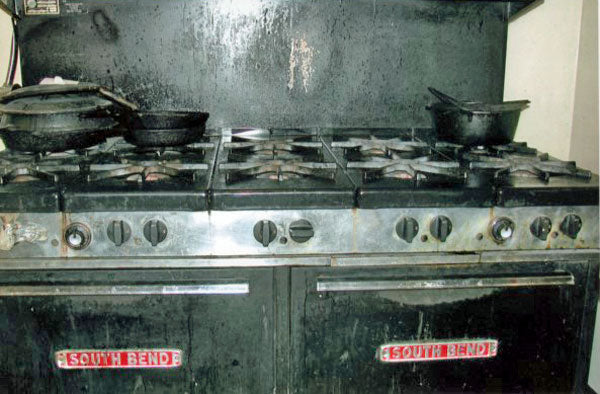
Stove rescued from a church. Propane, 10 burners, 2 ovens, no broiler. Very old.
I’ve used Ricki’s book(s) and supplies and recommend them to anyone wanting to take a chance on cheese making themselves.

Essential reading
Advice for beginners: Don’t get discouraged when things go awry. Like making bread, the cultures affecting milk are alive and can’t pushed into “obeying” what we want or think should happen next. Learn to be sensitive to the cultures’ own timing and character.

Loaded pizza with cow/sheep/goat fromagina






























